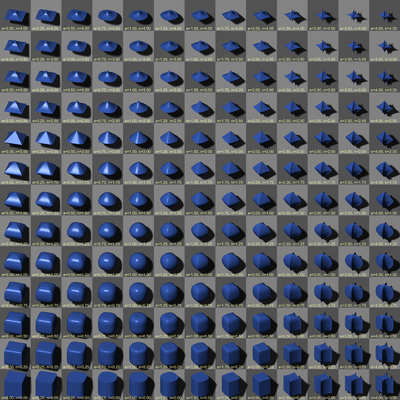Superellipsoid
In mathematics, a superellipsoid or super-ellipsoid is a solid whose horizontal sections are superellipses (Lamé curves) with the same exponent r, and whose vertical sections through the center are superellipses with the same exponent t.

Superellipsoids as computer graphics primitives were popularized by Alan H. Barr (who used the name "superquadrics" to refer to both superellipsoids and supertoroids).[2][3] However, while some superellipsoids are superquadrics, neither family is contained in the other.
Piet Hein's supereggs are special cases of superellipsoids.
Formulas
Basic shape
The basic superellipsoid is defined by the implicit inequality
The parameters r and t are positive real numbers that control the amount of flattening at the tips and at the equator. Note that the formula becomes a special case of the superquadric's equation if (and only if) t = r.
Any "parallel of latitude" of the superellipsoid (a horizontal section at any constant z between -1 and +1) is a Lamé curve with exponent r, scaled by :
Any "meridian of longitude" (a section by any vertical plane through the origin) is a Lamé curve with exponent t, stretched horizontally by a factor w that depends on the sectioning plane. Namely, if x = u cos θ and y = u sin θ, for a fixed θ, then
where
In particular, if r is 2, the horizontal cross-sections are circles, and the horizontal stretching w of the vertical sections is 1 for all planes. In that case, the superellipsoid is a solid of revolution, obtained by rotating the Lamé curve with exponent t around the vertical axis.
The basic shape above extends from −1 to +1 along each coordinate axis. The general superellipsoid is obtained by scaling the basic shape along each axis by factors A, B, C, the semi-diameters of the resulting solid. The implicit inequality is
Setting r = 2, t = 2.5, A = B = 3, C = 4 one obtains Piet Hein's superegg.
The general superellipsoid has a parametric representation in terms of surface parameters -π/2 < v < π/2, -π < u < π.[3]
where the auxiliary functions are
and the sign function sgn(x) is
The volume inside this surface can be expressed in terms of beta functions (and Gamma functions, because β(m,n) = Γ(m)Γ(n) / Γ(m + n) ), as:
References
- http://www.povray.org/documentation/view/3.6.1/285/
- Barr, A.H. (January 1981), Superquadrics and Angle-Preserving Transformations. IEEE_CGA vol. 1 no. 1, pp. 11–23
- Barr, A.H. (1992), Rigid Physically Based Superquadrics. Chapter III.8 of Graphics Gems III, edited by D. Kirk, pp. 137–159
- Aleš Jaklič, Aleš Leonardis, Franc Solina, Segmentation and Recovery of Superquadrics. Kluwer Academic Publishers, Dordrecht, 2000.
- Aleš Jaklič, Franc Solina (2003) Moments of Superellipsoids and their Application to Range Image Registration. IEEE TRANSACTIONS ON SYSTEMS, MAN, AND CYBERNETICS, 33 (4). pp. 648–657
External links
- Bibliography: SuperQuadric Representations
- Superquadric Tensor Glyphs
- SuperQuadric Ellipsoids and Toroids, OpenGL Lighting, and Timing
- Superquadratics by Robert Kragler, The Wolfram Demonstrations Project.